Submissions
Submission Preparation Checklist
As part of the submission process, authors are required to check off their submission's compliance with all of the following items, and submissions may be returned to authors that do not adhere to these guidelines.-
The request has not been previously published, it has not been submitted to another journal (or an explanation has been provided in Comments to the Editor).
-
The file is sent in OpenOffice, Microsoft Word, RTF, or WordPerfect format.
-
They have been added to the references web addresses where it has been possible.
-
The text has 1.5 pts line spacing; the font size is 12 points; used italics rather than underlining (except with URL addresses); and all illustrations, figures and tables are placed within the text in their proper place and not the end of everything.
-
The text complies with style and bibliographic requirements outlined in the Author Guidelines / s, which can be found in About the Journal.
-
If you are submitting to a section of the journal peer-reviewed, you have to make sure that the instructions in Ensuring a Blind Review) have been followed.
Artículos de investigación
En esta sección se publicará todos aquellos artículos productos de investigación que han sido enviados a la revista para el particpar del proceso de arbitraje.Reflexión
Artículos producto de la reflexión académica y científica.Revisión
Revisión científica y técnicas de temas de interés en el campo de las ciencias sociales.Traducción
Traducciones de textos clásicos o de actualidad o transcripciones de documentos históricos o de interés particular en el dominio de publicación de la revista.Artículo corto
Documento breve que presenta resultados originales preliminares o parciales de una investigación científica o tecnológica, que por lo general requieren de una pronta difusión.Reporte de caso
Documento que presenta los resultados de un estudio sobre una situación particular con el fin de dar a conocer las experiencias técnicas y metodológicas consideradas en un caso específico. Incluye una revisión sistemática comentada de la literatura sobre casos análogos.Revisión de tema
Documento resultado de la revisión crítica de la literatura sobre un tema en particular.Reseñas
Espacio para el fomento de la lectura en temas de interés relacionados con las ciencias sociales.Ensayos
Artículos no clasificados en los demás itemsCopyright Notice
The opinions contained in articles are those of the authors.
Katharsis permission to reproduce articles as long as the source is indicated.
The Katharsis magazine follows the policy of open access, free of cost and immediate access to its contents under the principle of making research available to the public. The magazine allows readers to download, print, share and use the content of texts published in any of its numbers, under the condition of an adequate reference of the original source. The magazine does not make any economic charge to submit, review, correct, edit, diagram and publish articles in any of its numbers.
Privacy Statement
The names and email addresses entered in this journal will be used exclusively for the stated purposes of this journal and will not be available for any other purpose or another person.



